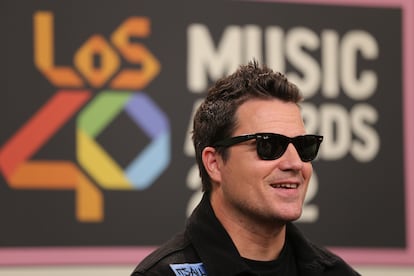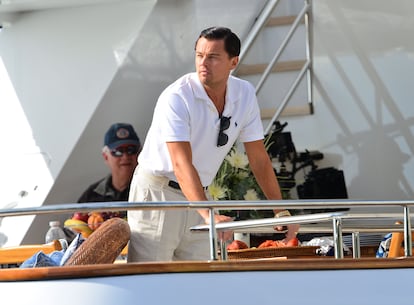How the Ray-Ban Wayfarer became the accessory of choice for the men-children of the world
The recognizable black frame has turned into a must-have for a certain kind of guy, while its more colorful version, once an indie darling, likewise refuses to fade away, having once again gained favor among the party animals

Last February, Rosalía was one of the stars invited to the fall-winter 2024-2025 Dior runway, which took place in Paris. Upon her arrival, she was swarmed by fans and photographers, who jostled each other, trying to get the best shot of the Catalan singer, dressed in an all-black outfit topped off by a down jacket and shades that completed the monochrome look. “Take off the sunglasses, Rosalía,” asked one of the photographers. “No no no, the look is with the sunglasses,” she responded, refusing to remove the pair. Perhaps Rosalía’s insistence had something to do with a sponsorship deal, but it did serve to underline the fact that the glasses she was sporting have played leading role both in and out of show business. And it does seem as though sunglasses have as much to say about the person who wears them as the rest of one’s wardrobe. Despite the fact that the average price of shades has risen 18.4% since 2019, sales of the accessory have gone up 14.8% since 2021, according to the most recent finding from the Libro Blanco de la visión en España (White Book of vision in Spain), which is put out by the Spanish Federation of Optical Sector Associations (FEDAO).
Experts say that fashion is one of the most elemental languages, introducing us to the world before we even open our mouth. Sunglasses accentuate this preconceived image, and for many, are as essential to everyday life as a pair of shoes. But Rosalía is, perhaps, not your usual Wayfarer-wearer. In Spanish singer Dani Martīn’s song Ester Expósito, the lyrics begin with the line, “Wayfarers always look good,” a nod to the Ray-Ban model without which the artist is rarely seen. The design has become synonymous with Spain’s canallita (little scoundrel) archetype, worn to hide a hangover and for rides on one’s scooter (a Vespa, if possible) through the center of Madrid and, in the case of Martín himself, to strut down a red carpet, as he did at the LOS 40 Music Awards in 2022. How can a simple pair of shades hold so much significance? Sophie Barre de Marco, product manager at sunglasses brand Jimmy Fairly, believes that certain frames achieve a status she considers, “iconic, because they become an extension of our personality, of our image.” In other words, all stereotypes aside, sunglasses have the ability to project something (whether it has positive or negative connotations) about their wearers. In the case of the Ray-Bans, one might say that not all Wayfarers are for canallitas, but all canallitas wear or have worn Wayfarers.
The preferred shade of ‘canallitas’ worldwide
The original Wayfarers feature an unusual 20-degree inclination in the frame, and were designed in 1952 by Ray-Ban optical designer Raymond Stegeman. In the 1980s, they enjoyed a moment in the sun thanks to Hollywood blockbusters. In Risky Business, Tom Cruise plays a wealthy U.S. teenage canallita who never leaves home without his Wayfarers. The design has proven timeless, and today nearly all eyewear companies offer Wayfarer-inspired frames, leading to their proliferation on streets the world over.
The first impression of someone wearing sunglasses is that of a person who “rids themselves, in the communicative sense, of any micro-expression that could reveal clues as to their appearance or position. That is to say, sunglasses, behind their functional purpose, act as a mask. However, each mask has its own meaning and refers to a contemporary archetype that may be deciphered,” says Llanos Gómez, professor of the sociology of fashion at Madrid’s University of Design, Innovation and Technology (UDIT). The so-called canallita is precisely the archetype that has come to be associated with the Wayfarers: commitment-shy, self-assured heterosexual men who love to party and are mildly interested in fashion, if only just enough to look good without standing out. Examples that come to mind include Jude Law, Jake Gyllenhaal, Leonardo DiCaprio (who has portrayed canallitas par excellence in films like The Wolf of Wall Street) and Maroon 5 singer Adam Levine, all of them international canallita elite and all of them Wayfarer-faithful. But if the global canallita community constitutes the standard-bearers of black Wayfarers, the eyewear model’s colored version certainly deserves its own mention.

The brightly-hued frame that defined a generation
Colorful Wayfarers were the most sought-after accessory of the hipster era, that long-ago age circa 2010, when the Artic Monkeys were topping the charts and music festival culture was morphing into the entertainment phenomenon we know today. Back then, the glasses formed part of the quintessential indie look that snuck into mainstream closets — but they had been revamped, not only with brightly-hued frames, but also mirrored lenses in iridescent orange, green and blue tones. Look to the era’s films to see proof of their journey from hip, esoteric accessory (at one point, even Sienna Miller wore colorful Wayfarers) to a bestseller embraced by canallitas, who did not hesitate to sport them indoors or even at the club, dance floors filling with shirtless dudes wearing hype-toned shades.
In the 2012 film The Place Beyond the Pines, Ryan Gosling plays a bleached-blonde, tattooed bank robber who wears Wayfarers with frames in an intense green color. A red version of the eyewear can be seen in Saltburn, a film set in 2006. In it, the Felix Catton character (played by Jacob Elordi), a wealthy, charismatic Oxford student, spends summer vacations at his mansion, sunbathing in a pair of crimson Ray-Bans that immediately link him to the look of the moment.
Perhaps serving as counterpoint are the colored sunglasses seen in programs like Jersey Shore and MTV Spring Break (whose parody might be found in the music video for LMFAO’s Sexy and I Know It, in which one of the singers appears in large white-framed glasses with no lenses) which irrevocably linked the accessory to party culture. 2014 comedy 22 Jump Street even put them on its promotional poster: its two protagonists, Jonah Hill and Channing Tatum, wore colored sunglasses in order to blend in as trendy teenage ravers.
With the passage of time, colored sunglasses have faded in popularity, but they refuse to disappear entirely and now reside in the somewhat tacky aesthetic championed by the canallitas, the scoundrels, the bad guys. Rosalía aside, Wayfarers are now largely seen on men who, in the middle of 2024, continue to display the affective responsibility of a peanut. They are not slaves to fashion (those who actually follow trends have long since stopped wearing the colored Wayfarer, or perhaps, wait patiently for their comeback), although they are slaves to their own image. Their archetype is perfectly represented in the second season of The White Lotus by Jack, played by the British actor Leo Woodall. Jack seduces the character of Portia (Haley Lu Richardson) with his brusque, direct attitude, so different from that of the timid Albie (Adam DiMarco), Portia’s other potential suitor. The two boys represent an interesting duality, which is built out in their contrasting wardrobe. Of course, Jack wears colored Wayfarers resting atop his head, combined with a graphic tee. He is the archetype of the problematic man-child who will not give up his brightly-hued shades, a hold-out of uncomplicated gauche.

Sign up for our weekly newsletter to get more English-language news coverage from EL PAÍS USA Edition
Tu suscripción se está usando en otro dispositivo
¿Quieres añadir otro usuario a tu suscripción?
Si continúas leyendo en este dispositivo, no se podrá leer en el otro.
FlechaTu suscripción se está usando en otro dispositivo y solo puedes acceder a EL PAÍS desde un dispositivo a la vez.
Si quieres compartir tu cuenta, cambia tu suscripción a la modalidad Premium, así podrás añadir otro usuario. Cada uno accederá con su propia cuenta de email, lo que os permitirá personalizar vuestra experiencia en EL PAÍS.
¿Tienes una suscripción de empresa? Accede aquí para contratar más cuentas.
En el caso de no saber quién está usando tu cuenta, te recomendamos cambiar tu contraseña aquí.
Si decides continuar compartiendo tu cuenta, este mensaje se mostrará en tu dispositivo y en el de la otra persona que está usando tu cuenta de forma indefinida, afectando a tu experiencia de lectura. Puedes consultar aquí los términos y condiciones de la suscripción digital.
More information
Archived In
Últimas noticias
Welcome to the post-religion era: The idea of Christianity as the absolute truth has become obsolete
‘I thought you would like it’: The risky sexual practice popularized by TV shows and TikTok
The digitalization of tourism: ‘They promise experiences and gave us the worst possible one’
Mexican peso defies uncertainty with forecasts of a new period of stability in 2026
Most viewed
- Sinaloa Cartel war is taking its toll on Los Chapitos
- Oona Chaplin: ‘I told James Cameron that I was living in a treehouse and starting a permaculture project with a friend’
- Reinhard Genzel, Nobel laureate in physics: ‘One-minute videos will never give you the truth’
- Why the price of coffee has skyrocketed: from Brazilian plantations to specialty coffee houses
- Silver prices are going crazy: This is what’s fueling the rally










































